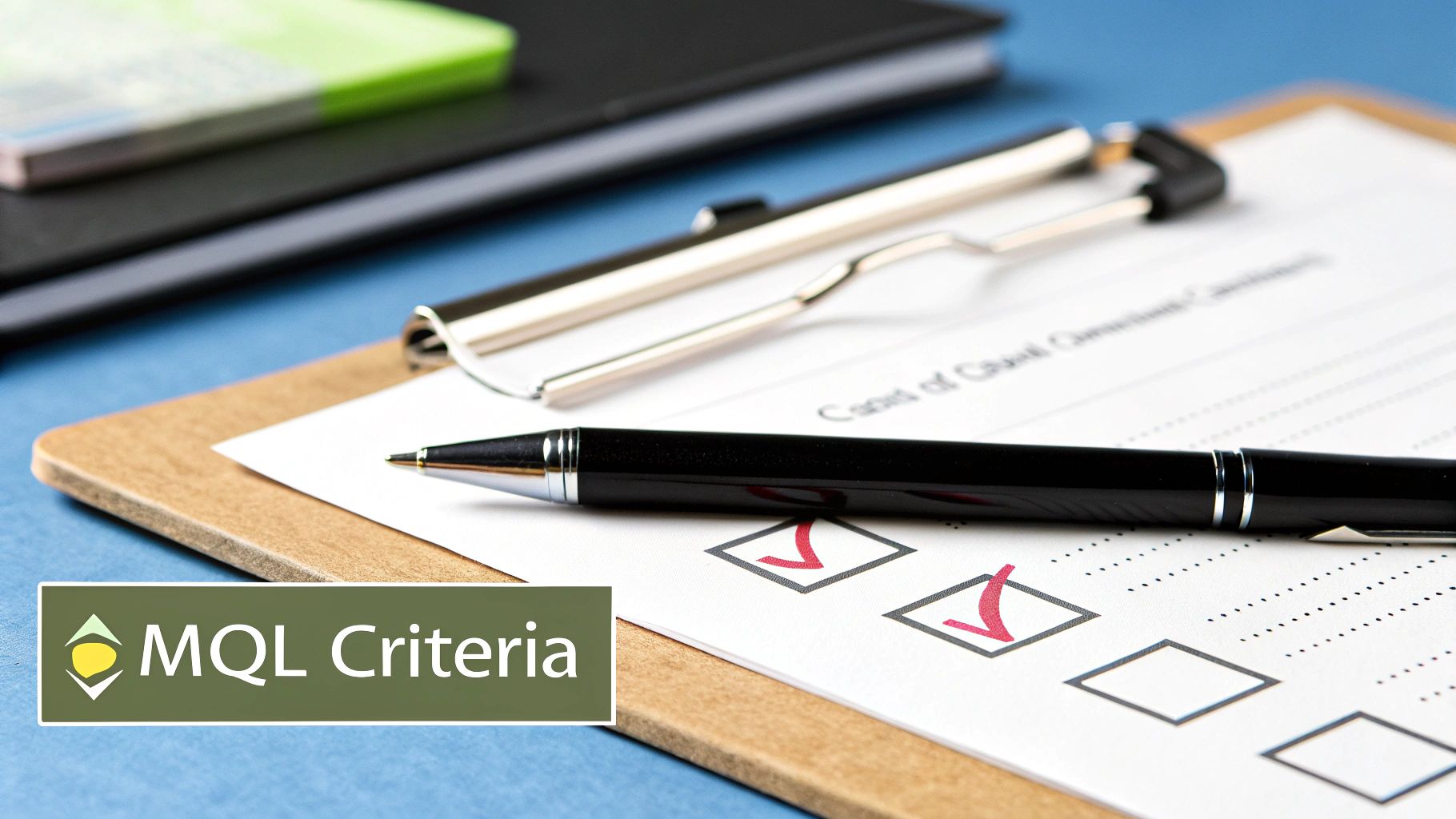Let's cut through the jargon. A Marketing Qualified Lead (MQL) isn't just a random contact; it's someone who has moved beyond casual browsing and shown real interest in what you offer.
Think of it like this: a regular lead is a window shopper. They might glance at your store as they walk by. An MQL, on the other hand, is the person who walks inside, starts looking at specific products, and maybe even asks an employee a question. They’re no longer just looking—they're actively considering a purchase.
What a Marketing Qualified Lead Really Is

At its core, an MQL comes down to one simple thing: intent. It’s a prospect whose engagement clearly signals they are more likely to become a customer compared to others. Their actions show they’ve started the buyer’s journey all on their own.
These actions are the digital equivalent of raising a hand. While a general lead might have simply subscribed to your newsletter, an MQL takes much more significant steps. They might download a detailed case study, sign up for a product webinar, or keep coming back to your pricing page. These behaviors, combined with a profile that matches your ideal customer, are what turns a simple contact into a promising lead. To dive deeper, you can find more insights about MQL criteria from industry experts.
Key Differences Between a Lead and an MQL
Not all leads are created equal, and knowing the difference is critical. The main distinction lies in their level of engagement and how qualified they are. A general lead is sitting at the very top of your sales funnel, often just showing a flicker of curiosity. An MQL has moved far past that stage.
An MQL represents a crucial handoff point. It’s the moment marketing says, "This person is genuinely interested and fits our ideal customer profile. They're ready for a conversation."
This simple distinction saves your sales team from wasting valuable time on prospects who just aren't ready to buy. By focusing their energy on MQLs, they can have more meaningful conversations with a warmer, more receptive audience.
The table below breaks down the key differences between a general lead and a qualified MQL.
Key Differences Between a Lead and an MQL
| Characteristic | General Lead | Marketing Qualified Lead (MQL) |
|---|---|---|
| Engagement Level | Low; passive interest like a blog subscription. | High; active interest like a demo request. |
| Intent Signal | Weak or non-existent. | Strong; repeated visits to pricing or product pages. |
| Data Provided | Minimal; often just an email address. | Rich; provides job title, company, and needs. |
Recognizing these distinctions helps streamline the entire sales process, ensuring that the right leads get the right attention at the right time.
Pinpointing Your Ideal MQLs in the Wild
So, how do you actually spot a marketing qualified lead? It’s not about finding one magic signal. It's about connecting two key puzzle pieces: their actions (behavioral data) and who they are (demographic or firmographic data). A truly qualified lead sits right at the intersection of both.
Think of it like being a detective. A single clue rarely solves a case. In the same way, a single action—like a one-time blog visit—doesn’t create an MQL. You need a pattern of evidence that points to genuine interest from someone who actually fits your ideal customer profile.
The Two Sides of MQL Qualification
To build a reliable system, you have to define clear criteria for both behavioral and demographic signals. This is the only way to get your marketing and sales teams perfectly aligned and chasing the same high-value leads.
-
Behavioral Data: This is all about what a prospect does. It's their digital body language. Are they just browsing, or are they leaning in with real intent? An MQL might repeatedly visit your pricing page or download an advanced resource like a case study, not just a beginner’s checklist.
-
Firmographic/Demographic Data: This is all about who the prospect is. Do they match your target audience? A manager from your key industry visiting your demo page is far more valuable than an intern from an unrelated field doing the exact same thing.
Modern frameworks often use a scoring system to weigh these actions and attributes. For instance, a lead scoring model might assign higher points for direct interactions like booking a demo, followed by repeated visits to high-value pages. You can find more insights on MQL scoring frameworks to help build your own.
Key Takeaway: An MQL isn't just defined by what they do but also by who they are. The strongest leads show high-intent behaviors and perfectly match your ideal customer profile.
This combination of data is crucial. Once you identify a promising contact, for example, you need to make sure their information is accurate before handing it off to sales. A quick check can teach you how to tell if an email address is valid, preventing wasted effort on dead-end contacts. Ultimately, pinpointing MQLs is about building a repeatable process that separates the genuinely promising prospects from the crowd.
How MQLs Bridge Marketing and Sales
A Marketing Qualified Lead is much more than just a contact—it's the critical handoff point between your marketing efforts and your sales team. Think of marketing as the scout who finds the promising trails and sales as the guide who leads the expedition. The MQL is the moment the scout hands the map to the guide, making sure the transition is seamless.
This handoff is absolutely essential. It stops the sales team from wasting precious time chasing down cold leads who aren't anywhere near ready to talk. By creating a clear definition of an MQL, you build an efficient system where sales can focus all their energy on prospects who have already shown real interest. This approach doesn't just improve productivity; it dramatically shortens the sales cycle.
Visualizing the MQL Handoff
So, how does a random website visitor become an MQL? It all comes down to tracking their engagement, scoring their actions, and finally, flagging them as ready for sales.

As you can see, automated systems are key here. They help filter through the noise and elevate the most engaged prospects, ensuring that only the warmest leads get passed along.
But the journey doesn't stop there. Modern sales and marketing teams usually break it down into three stages: the Marketing Qualified Lead (ready to be nurtured), the Sales Accepted Lead (sales agrees to engage), and finally, the Sales Qualified Lead (a genuine sales opportunity).
This structured handoff is more than just a process; it's a pact between marketing and sales. It ensures that marketing delivers real value and sales receives leads with a much higher chance of converting.
Validating contact information at this stage is also a must. Before sales even thinks about outreach, it's vital to understand why email verification is essential for B2B campaigns. This simple step prevents your team from wasting time on bad contacts and protects your sender reputation. When all these pieces are aligned, the sales funnel transforms into a well-oiled machine.
From Theory to Reality: What MQLs Look Like in the Wild
Definitions are great, but the best way to really wrap your head around the idea of a marketing qualified lead is to see it in action. Let's move beyond the abstract and look at a few real-world scenarios that businesses run into every single day.

Picture this: you run a B2B software company. A project manager from a 200-person tech firm—smack in the middle of your ideal customer profile—downloads your newest case study. A few hours later, they come back to your site and spend five minutes checking out your pricing page.
That combination of demographic fit (right company, right role) and high-intent behavior (reviewing pricing) is exactly what makes them a strong MQL. It's a clear signal that they're worth a salesperson's time.
This same logic holds up across different industries. The specific actions and job titles might change, but the core idea is always the same.
Common MQL Scenarios
Translating the MQL concept into concrete examples helps your team spot valuable leads quickly. You’re just looking for that sweet spot where a person’s profile lines up with actions that signal genuine interest.
Here are a few more examples:
-
SaaS Industry MQL: A marketing director from a target company signs up for your webinar on "Advanced Analytics." A day later, they're back on your site, looking at your integration features page. Their title shows they have influence, and their interest in advanced content means they’re not just kicking tires.
-
E-commerce MQL: Someone adds three high-value items to their cart but gets distracted and leaves. Twenty-four hours later, they click a link in your abandoned cart email to come back and look again. That click shows their interest has been rekindled, making them a hot lead for your sales team to follow up on.
By defining scenarios like these, you create a shared language between marketing and sales. Everyone knows exactly what a "good lead" looks like, which is the first real step toward building a sales funnel that actually works.
These examples aren't just hypotheticals. They represent the daily breadcrumbs your marketing team can follow to identify the most promising prospects. Each action is a clue that a prospect is inching closer to making a purchase.
Turning Warm Leads Hot Through Nurturing
Identifying a marketing qualified lead is a great start, but it's just the beginning. Most MQLs aren't ready to pull out their credit card the second your system flags them. Pushing them straight to a salesperson can feel abrupt—like asking for a commitment on a first date.
This is where smart lead nurturing comes in. It’s the art of building trust and staying top-of-mind without being aggressive or pushy. Think of it as the engine that turns interested prospects into sales-ready leads.
Unfortunately, a shocking number of businesses get this wrong. Research shows that a staggering 79% of MQLs never convert into sales, often because of poor nurturing. You can discover more insights about lead conversion challenges on Salesgenie. That gap represents a massive opportunity for teams willing to invest in a thoughtful follow-up strategy.
Proven Nurturing Strategies
So, how do you keep the conversation going? The goal is to provide value, not just a sales pitch. You can do this with a mix of automated and personalized tactics that gently guide the prospect toward a decision.
-
Targeted Email Sequences: Ditch the generic newsletters. Instead, build automated email workflows that deliver content directly related to what your MQL was interested in. If they downloaded your guide on B2B outreach, your follow-up emails should be packed with case studies and tips on that exact topic.
-
Personalized Follow-Ups: Pay attention to their activity. Did an MQL just revisit your pricing page a week after their first visit? That's the perfect trigger for a helpful, direct email from a sales rep.
-
Strategic Retargeting: Use retargeting ads on social media or search engines to gently remind them of the value you offer. Showcasing a customer testimonial or a special offer can keep your brand visible while they continue their research.
The essence of nurturing is patience and relevance. You're building a relationship by consistently proving you understand their problem and have the solution for it.
Before you launch any email nurturing campaign, it's critical to make sure your contact data is accurate. Our guide offers a practical approach to email list cleaning that prevents your valuable messages from bouncing.
By combining clean data with strategic nurturing, you can turn potential missed opportunities into your most valuable sales conversations.
How Automation Streamlines MQL Management

Let's be real—trying to manually track every click, download, and page visit for hundreds of leads is a recipe for disaster. It's just not scalable. This is exactly where technology steps in, transforming a messy, chaotic process into a well-oiled machine for spotting your best prospects.
Think of marketing automation platforms like HubSpot or Marketo as your team's command center. They automatically watch for engagement, apply your lead scoring rules in real-time, and shuffle contacts into the right nurturing campaigns without anyone lifting a finger. This systematic approach saves a ton of hours and guarantees every lead gets evaluated the same way.
The difference this makes is staggering. According to Gartner Research, businesses that lean on marketing automation see a 451% increase in qualified leads. That number really drives home how technology bridges the gap between your marketing efforts and handing over sales-ready prospects. You can read the full research about these findings to see the data for yourself.
The Core Benefits of an Automated System
When you take the manual guesswork out of the equation, you bring a new level of precision and efficiency to your MQL strategy. It lets your team get back to what they do best—creating great content and building relationships—instead of getting buried in administrative busywork.
Here’s where it really pays off:
- Consistency: Every single lead is scored against the exact same criteria. This gets rid of human bias and ensures your marketing qualified leads definition is applied uniformly across the board.
- Efficiency: Actions that would take hours to do by hand, like tracking website visits or updating a lead’s score, happen instantly. This frees up your team for more strategic, high-impact work.
- Data-Driven Refinement: Automation tools give you the analytics you need to see what’s actually working. You can quickly pinpoint which content or actions are generating the highest-quality leads and tweak your MQL criteria over time for even better results.
In the end, automation turns your MQL process from a reactive, manual chore into a proactive, scalable system. It makes sure no promising lead slips through the cracks and keeps a reliable flow of warm prospects heading to your sales team.
Answering Your Top MQL Questions
Even with a solid grasp of what a marketing qualified lead is, a few questions always seem to pop up. Let's walk through the most common ones so you can build your strategy on a rock-solid foundation.
What Is the Main Difference Between an MQL and an SQL?
Think of it like a two-step handshake.
An MQL (Marketing Qualified Lead) is a prospect that marketing has identified as a good fit. Based on their behavior and profile, they’ve essentially raised their hand and shown interest. But they might not be ready to pull out their credit card today.
An SQL (Sales Qualified Lead) is what happens next. The sales team personally vets that MQL and gives it the green light. They’ve confirmed it's a real, legitimate opportunity worth a direct conversation. It's the official handoff from marketing to sales.
What Happens If Sales Rejects an MQL?
First off, this isn't a failure—it's a normal, healthy part of the process.
When sales rejects an MQL, the lead simply gets passed back to the marketing team for a bit more nurturing. They might get added to a long-term educational email sequence or receive different content until they show stronger signs of being ready to buy.
This feedback loop is pure gold. It helps marketing learn exactly what sales considers a "qualified" lead, which is absolutely critical for sharpening your MQL definition over time.
How Often Should We Review Our MQL Definition?
Your MQL definition should never be set in stone. Market conditions change, your ideal customer might evolve, and your sales team’s needs will shift.
It's a best practice to sit down with your sales team and review it at least once a quarter. This keeps everyone aligned with your business goals and ensures you’re continuously improving the quality of leads you generate. And before you hand those leads over, make sure they’re actually deliverable—it’s crucial to learn how to reduce bounce rates with email validation tools to protect your sender reputation.

